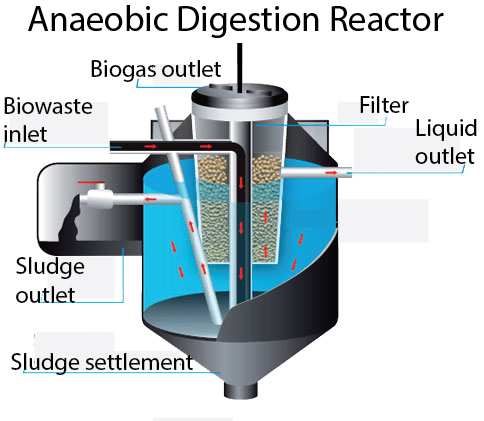More About:
 Residential Biodegradable Waste Processing Green New World’s current efforts are focused on maximizing the residential recycling potential of biodegradable materials including waste water (blackwater and greywater), food wastes and garden wastes. There are several methods to process biodegradable wastes by microorganisms that brake down the waste and convert it into beneficial products such as fertilizer and biogas. A model for a residence designed by Green New World uses a system that processes all biodegradable wastes on site in an anaerobic biodigestion reactor also known as a biodigester. An anaerobic biodigestion reactor contains mesophyllic bacteria that process the biological waste and converts it into biogas. The amount of water introduced into the anaerobic biodigestion reactor is critical to the process and works best with a water recycling system where every drop of water is reused four to seven times within the residence (see Water for details) so that the input of water into the anaerobic biodigestion
Residential Biodegradable Waste Processing Green New World’s current efforts are focused on maximizing the residential recycling potential of biodegradable materials including waste water (blackwater and greywater), food wastes and garden wastes. There are several methods to process biodegradable wastes by microorganisms that brake down the waste and convert it into beneficial products such as fertilizer and biogas. A model for a residence designed by Green New World uses a system that processes all biodegradable wastes on site in an anaerobic biodigestion reactor also known as a biodigester. An anaerobic biodigestion reactor contains mesophyllic bacteria that process the biological waste and converts it into biogas. The amount of water introduced into the anaerobic biodigestion reactor is critical to the process and works best with a water recycling system where every drop of water is reused four to seven times within the residence (see Water for details) so that the input of water into the anaerobic biodigestion  reactor is minimized to maintain a high percentage of solids. In Green New World’s water recycling system only a high efficiency flush toilet with 1.2 gallons per flush (4.6 liters) or 0.6 gallon (2.3 liters) and one drain from the kitchen with a biowaste disposal grinder feed directly into the anaerobic biodigestion reactor so that the average daily use of water per person is less than 20 gallons (76 liters) per day. This ensures a high ratio of volatile solid to liquid ratio in the anaerobic biodigestion reactor which is beneficial for the efficient production of biogas. Depending on the size of the household and average daily input of biodegradable wastes the output of biogas can be substantially enhanced by coupling the anaerobic biodigestion reactor to an algae biofuel reactor. Nutrients for the algae are provided for from the liquid effluent of the anaerobic biodigestion reactor and the carbon dioxide exhaust from the biogas generator or other sources of combustible residential emissions. Feeding algae with carbon dioxide emissions creates a closed loop system where most carbon that is introduced into this waste processing system is captured and reused which provides an additional benefit to the environment by capturing the carbon dioxide and avoiding the release into the atmosphere. Good results with biofuel algae have been obtained with Chorella a type of green algae which is heterotrophic and has a high protein and fat content and is well suited for anaerobic biodigestion and biogas production. An additional factor used to gage the amount of algae that is required to balance the nutrient content of the anaerobic biodigestion reactor is the amount of nitrogenous and carbonaceous materials. A carbon to nitrogen ratio of 20:1 to 30:1 generates the maximum amount of biogas. The anaerobic digestion reactor contains three outlets for gas, liquid and solid effluent. The gas output consists mostly of biogas (60-70% methane) after the impurities of carbon dioxide, water and hydrogen sulfide are removed by a process known as scrubbing, pure methane gas provides for cooking, residential hot water and to power a peak demand electric generator. The liquid effluent provides consistent and safe irrigation to orchards through divided subterranean leachfields and also provides nutrients for the biofuel algae as described above. The solid effluent known as sludge can be utilized in several ways such as making organic fertilizer, to feed biofuel algae or to make combustible biobricks or biopellets. Integration of an anaerobic digestion reactor into a residential household sewage system maximizes environmental benefits as it integrates with the water recycling system, energy production and carbon dioxide sequestration.
reactor is minimized to maintain a high percentage of solids. In Green New World’s water recycling system only a high efficiency flush toilet with 1.2 gallons per flush (4.6 liters) or 0.6 gallon (2.3 liters) and one drain from the kitchen with a biowaste disposal grinder feed directly into the anaerobic biodigestion reactor so that the average daily use of water per person is less than 20 gallons (76 liters) per day. This ensures a high ratio of volatile solid to liquid ratio in the anaerobic biodigestion reactor which is beneficial for the efficient production of biogas. Depending on the size of the household and average daily input of biodegradable wastes the output of biogas can be substantially enhanced by coupling the anaerobic biodigestion reactor to an algae biofuel reactor. Nutrients for the algae are provided for from the liquid effluent of the anaerobic biodigestion reactor and the carbon dioxide exhaust from the biogas generator or other sources of combustible residential emissions. Feeding algae with carbon dioxide emissions creates a closed loop system where most carbon that is introduced into this waste processing system is captured and reused which provides an additional benefit to the environment by capturing the carbon dioxide and avoiding the release into the atmosphere. Good results with biofuel algae have been obtained with Chorella a type of green algae which is heterotrophic and has a high protein and fat content and is well suited for anaerobic biodigestion and biogas production. An additional factor used to gage the amount of algae that is required to balance the nutrient content of the anaerobic biodigestion reactor is the amount of nitrogenous and carbonaceous materials. A carbon to nitrogen ratio of 20:1 to 30:1 generates the maximum amount of biogas. The anaerobic digestion reactor contains three outlets for gas, liquid and solid effluent. The gas output consists mostly of biogas (60-70% methane) after the impurities of carbon dioxide, water and hydrogen sulfide are removed by a process known as scrubbing, pure methane gas provides for cooking, residential hot water and to power a peak demand electric generator. The liquid effluent provides consistent and safe irrigation to orchards through divided subterranean leachfields and also provides nutrients for the biofuel algae as described above. The solid effluent known as sludge can be utilized in several ways such as making organic fertilizer, to feed biofuel algae or to make combustible biobricks or biopellets. Integration of an anaerobic digestion reactor into a residential household sewage system maximizes environmental benefits as it integrates with the water recycling system, energy production and carbon dioxide sequestration.

Another way to process biodegradable waste is to use an aerobic biodigestion reactor which in contrast to anaerobic digestion requires oxygen hence is an energy intensive process and can provide heat and organic fertilizer however is not as environmentally advantageous in comparison to anaerobic digestion as much of the nutrients are lost to the atmosphere in form of nitrous oxide and carbon dioxide.



